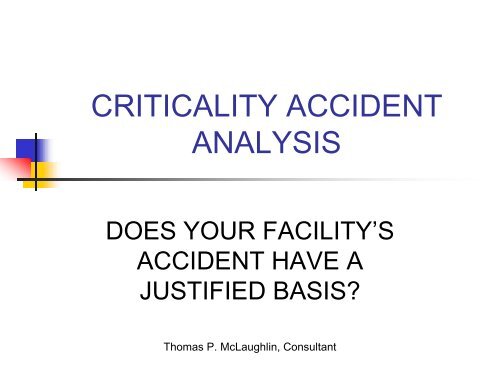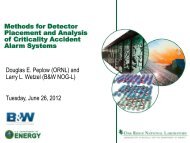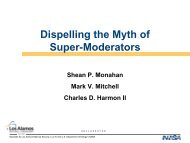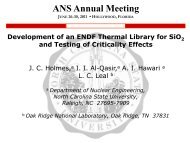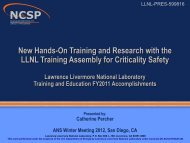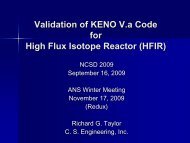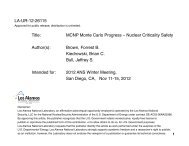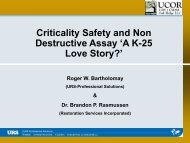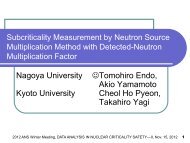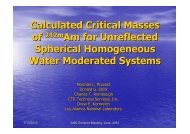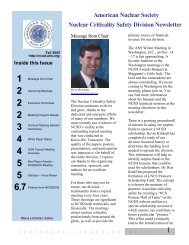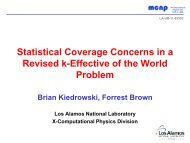Criticality Accident Analysis - Nuclear Criticality Safety Division
Criticality Accident Analysis - Nuclear Criticality Safety Division
Criticality Accident Analysis - Nuclear Criticality Safety Division
Create successful ePaper yourself
Turn your PDF publications into a flip-book with our unique Google optimized e-Paper software.
CRITICALITY ACCIDENTANALYSISDOES YOUR FACILITY’SACCIDENT HAVE AJUSTIFIED BASIS?Thomas P. McLaughlin, Consultant
OVERVIEW• What is a Justified Basis?• Regulatory Drivers• Resources for Determining (Credible)<strong>Accident</strong>s and Power Histories• Data Application Example• Conclusions
WHAT IS A JUSTIFIEDBASIS?• More than an “approved” or “authorized”handbook value• CREDIBILITY - both in Likelihood andConsequence, i.e., data-based.• In spite of compliance with ANS-8.1,Section 4.1.2, Process <strong>Analysis</strong>:• Before a new process ….. it shall bedetermined that … subcritical … andcredible abnormal conditions.• Roll-up issues?
REGULATORY DRIVERS• ANSI/ANS-8.23, <strong>Nuclear</strong> <strong>Criticality</strong> <strong>Accident</strong>Emergency Planning and Response, 5.1.1• Potential criticality accident locations andpredicted accident characteristics shall beevaluated and documented ….• This description may be based on professionaljudgment or a more detailed analysis.• The description should include the estimatedfission yield.• The likelihood of recurrence should be considered
REGULATORY DRIVERS• ANSI/ANS-8.23, <strong>Nuclear</strong> <strong>Criticality</strong> <strong>Accident</strong>Emergency Planning and Response, 5.1.2• An immediate evacuation zone shall beestablished based on the documented evaluation.• Emergency response planning shall shall establisha maximum acceptable value for the absorbeddose at the IEZ boundary.• The basis for the maximum acceptable value shallbe documented.
RESOURCES FOR DETERMININGACCIDENT CREDIBILITY• Process Supervisors and Operators• <strong>Accident</strong> Reports (e.g., LA-13638)• Analyses of actual and postulated accidents,such as the ICNC’91 review paper: <strong>Criticality</strong><strong>Accident</strong> Likelihoods, Consequences, andEmergency Planning by T. P. McLaughlin
RESOURCES FOR DETERMININGPOWER HISTORIES• ANS-8.23 APPENDIX C• <strong>Accident</strong> simulation data: KEWB, CRAC,SILENE, SHEBA, TRACY• ORNL Slide Rule• <strong>Accident</strong> Report, LA-13638• DOE Handbook 3010-94, Airborne Release Fractions/Rates for Nonreactor<strong>Nuclear</strong> Facilities, Chapter 6• NUREG/CR-6410, <strong>Nuclear</strong> Fuel Cycle Facility <strong>Accident</strong> <strong>Analysis</strong> Handbook
CRITICALITY ACCIDENTSIMULATION DATA1110987CRAC DataKEWB DataInitial Conditions are 1.0Atmosphere and 20 o C.1110987Fissions / liter x 10 -15665454332112101000100Period (milliseconds)0101Specific fissions in first spike vs reactor period
CRITICALITY ACCIDENTSIMULATION DATA
CRITICALITY ACCIDENTSIMULATION DATABounding fission density vs time, CRAC & SILENE
ORNL SLIDE RULE• Based heavily on CRAC data• Very easy to apply and has many additionalfeatures/capabilities• Appears to have a reactivity insertion rate to the halfpower dependence that results in increasingconservatism at higher ramp rates compared toCRAC data, for the first spike yield.
DOE and NRC HANDBOOKS• Little discussions of likelihoods with differentmedia• Recommended bounding total fissions only(with inadequate justification) - no breakdowninto first spike and plateau (DOE)• Describes hypothetical scenario fromwithdrawn RG’s 3.33, 3.34, and 3.35:• 1.0+18 in first spike followed by 47 pulses of1.9+17 at 10 minute intervals over 8 hours for1.0+19 total fissions. (NRC)
CONCLUSIONS -1• <strong>Accident</strong> experience, augmented bycommon-sense reasoning, supports thecontention that non-solution processcriticality accidents are inherently muchless likely than those that might occur insolution operations.• The INCN’91 paper examines this in somedetail. Subsequent accident revelationsreinforce this paper’s conclusions.
CONCLUSIONS -2• Given the negligible accident rate innon-solution media (one reported, withdeliberate violations) it would seemdifficult to justify emergency plans andprocedures, including a CAAS, foroperations with fissile material only indry forms. This conclusion is based onboth risk and cost issues.
CONCLUSIONS -3• For operations with significant quantitiesof fissile materials in solution form, thereis much relevant (accident simulation)data and more being generated.Practically all site- and process-specificcriticality accident characterizations andevaluations should be able to beperformed readily by the directapplication of these data.


